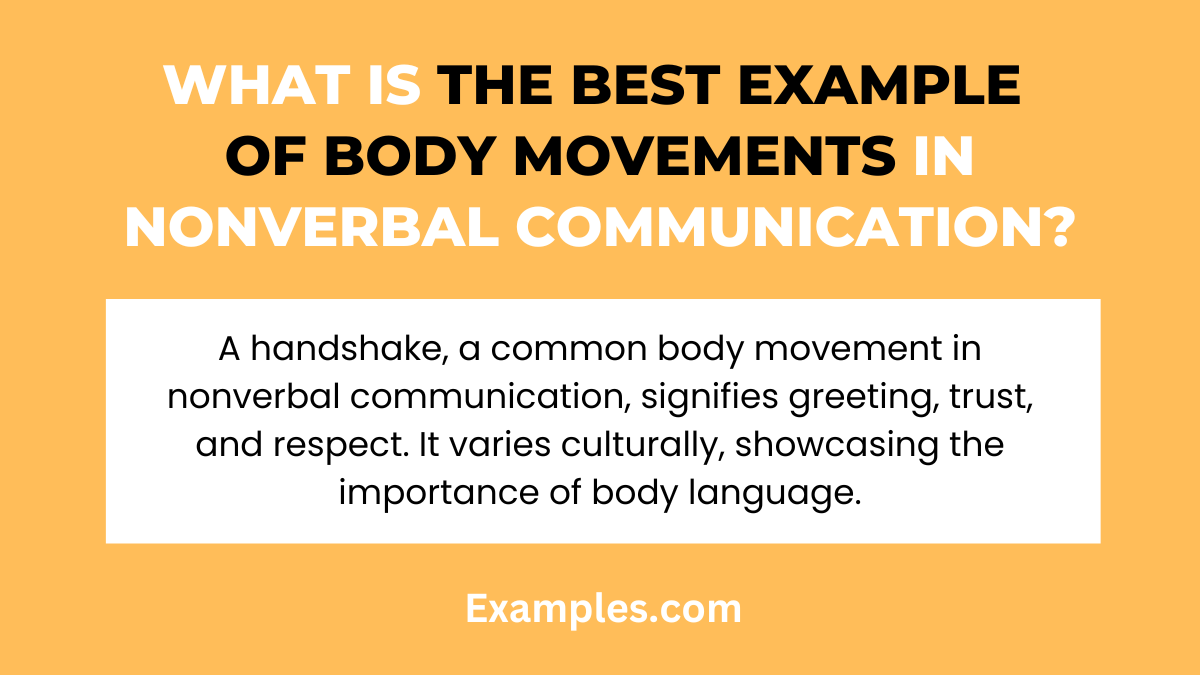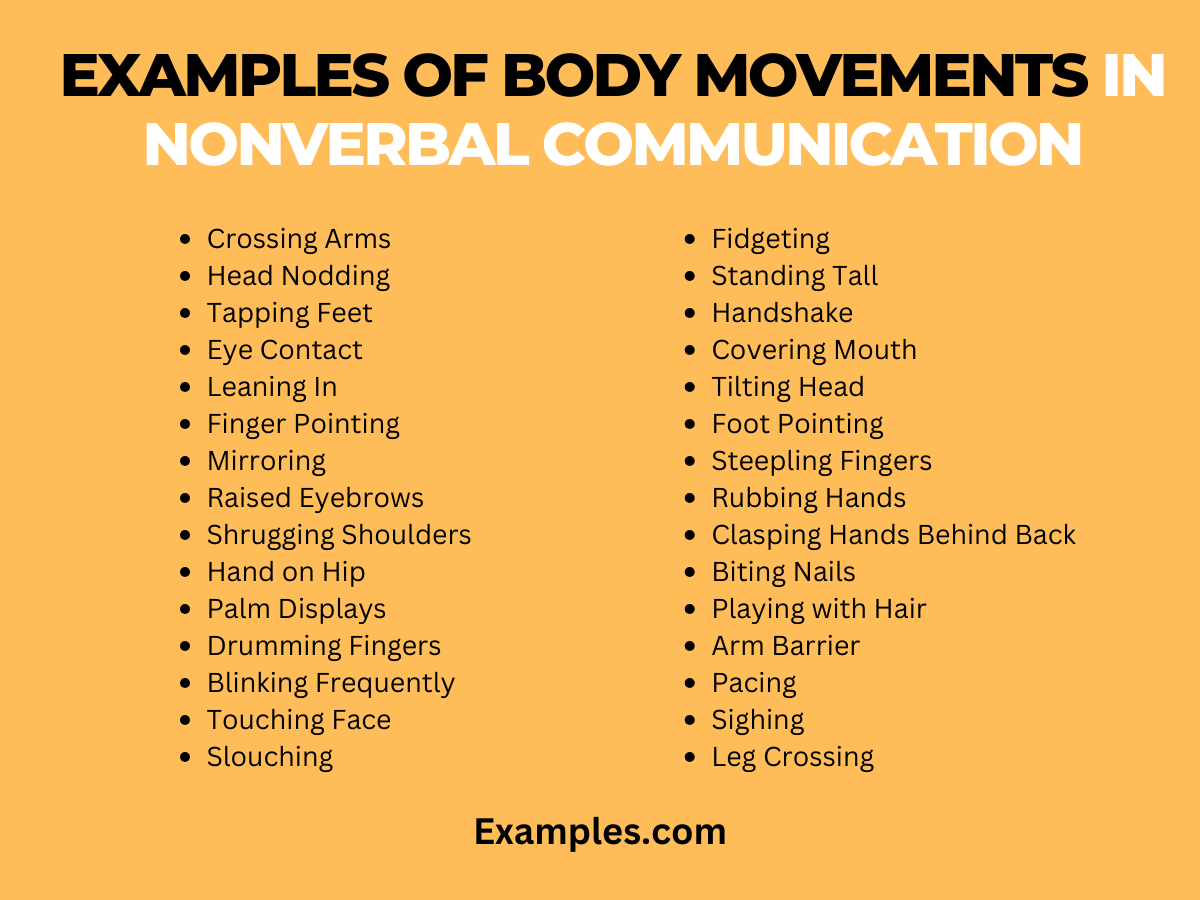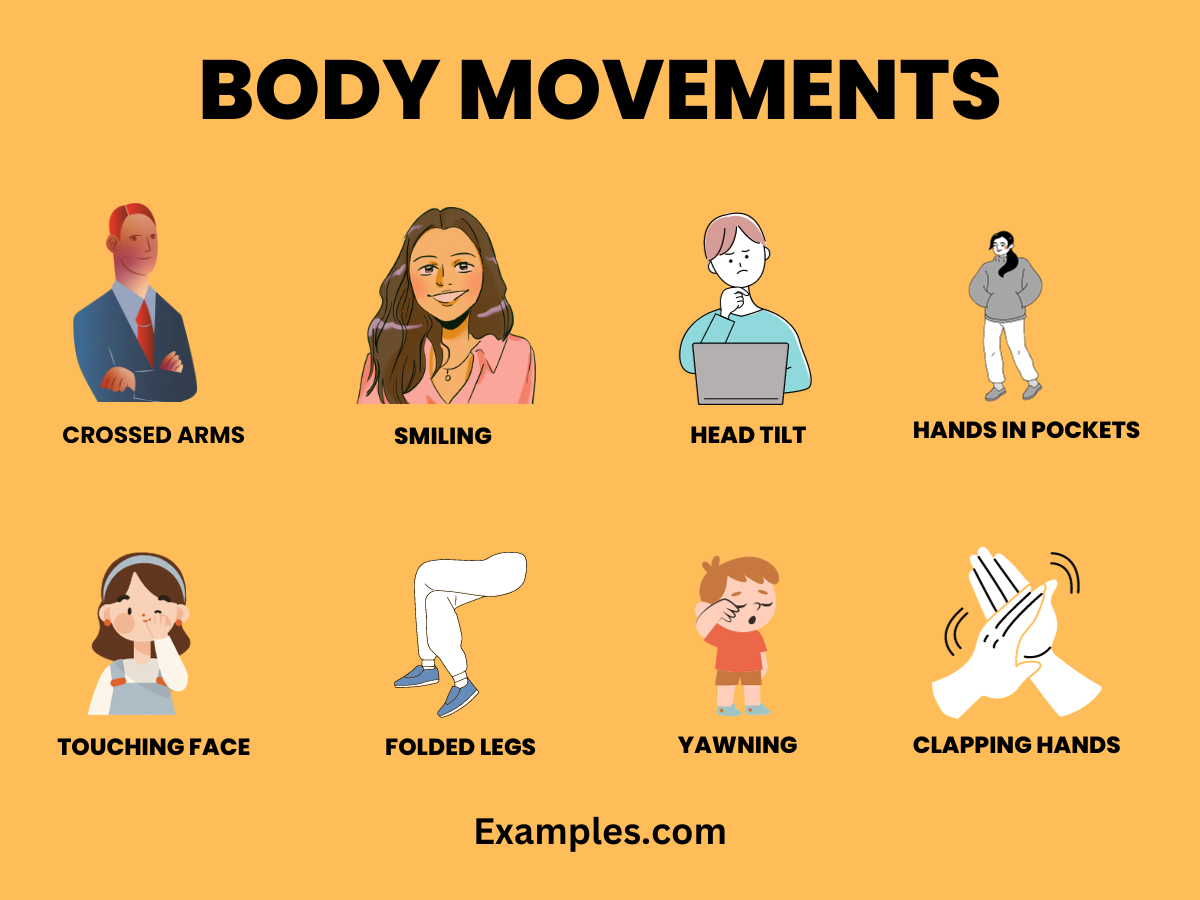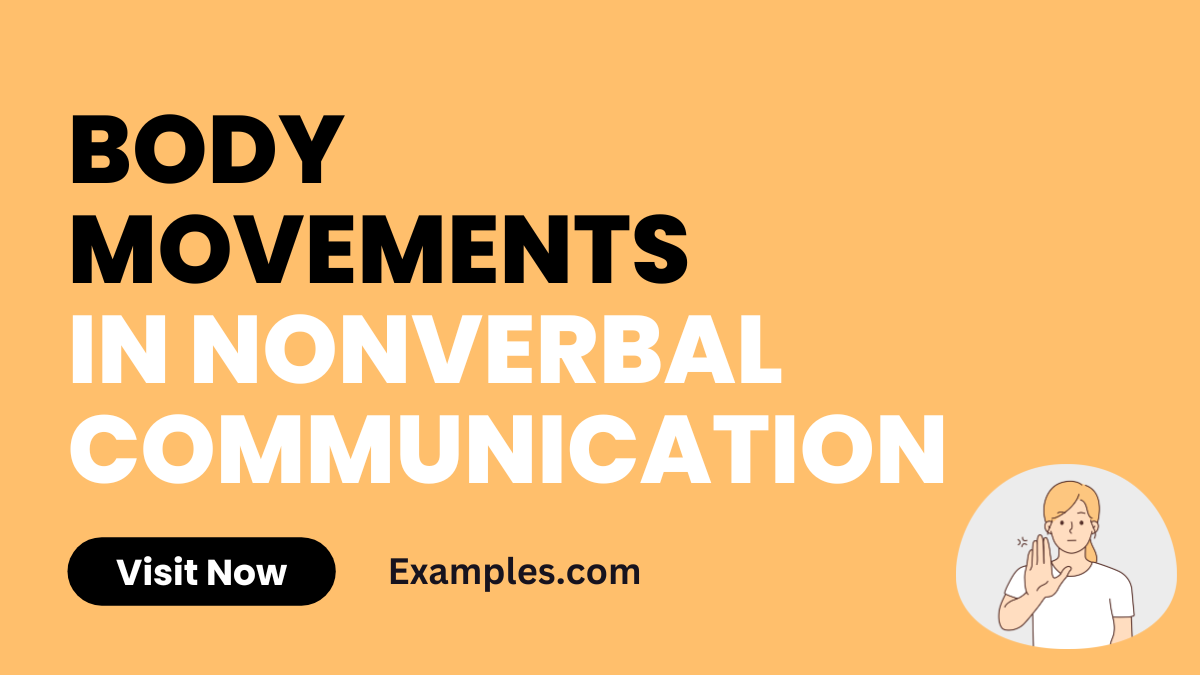Body Movements in Nonverbal Communication
In the realm of Nonverbal Communication, body movements play a pivotal role in conveying messages without uttering a single word. This guide delves into the subtle yet powerful language of body movements, providing practical examples to enhance understanding. From the subtle nod to expressive gestures, every movement carries meaning. These Communication Examples are crucial in everyday interactions, offering insights into emotions, intentions, and reactions. Understanding these nonverbal cues can significantly enhance interpersonal communication and build stronger connections.
What are Body Movements in Nonverbal Communication?

Body movements in Nonverbal Communication refer to the physical gestures, postures, and movements that convey messages without the use of words. These can range from facial expressions and hand movements to broader gestures like nodding or shaking the head. These movements are an integral part of how we communicate and are often subconscious, yet they can convey a wealth of information about our thoughts, feelings, and intentions.
What is the best Example of Body Movements in Nonverbal Communication?

One of the best examples of body movements in Nonverbal Communication is the use of hand gestures while speaking. Hand gestures can emphasize points, illustrate concepts, and express emotions, enhancing the verbal message. For instance, an open palm can indicate honesty or submission, while pointing can be seen as accusatory or directive. These gestures, alongside other body movements, play a critical role in reinforcing or sometimes even contradicting the spoken word, making them essential components of effective communication.
30 Examples of Body Movements in Nonverbal Communication

Nonverbal communication plays a crucial role in conveying messages without words. Body movements, one of the key types of nonverbal communication, significantly influence how we interpret messages and emotions. Understanding these movements can enhance interpersonal skills and foster better understanding in various social and professional contexts. This article delves into 30 distinct body movements, explaining their significance and providing examples of how they can be used effectively in communication.

- Crossing Arms: A defensive or self-protective gesture. It can indicate discomfort or disagreement.
Example: “When criticized, she crossed her arms, showing her discomfort with the feedback.” - Head Nodding: Indicates agreement or acknowledgment. It’s a positive response in most cultures.
Example: “He nodded his head while listening, showing he understood and agreed with the points being made.” - Tapping Feet: Sign of impatience or nervousness. It can show eagerness to leave or act.
Example: “Her tapping feet under the table signaled her impatience to end the meeting.” - Eye Contact: Shows confidence and interest. Lack of it might indicate dishonesty or discomfort.
Example: “Maintaining eye contact, she conveyed her sincerity and confidence in the proposal.” - Leaning In: Indicates interest and engagement in the conversation.
Example: “He leaned in towards the speaker, showing his keen interest in the discussion.” - Finger Pointing: Can be aggressive or accusatory. It’s often seen as rude.
Example: “Pointing his finger, he aggressively made his point, which seemed confrontational.” - Mirroring: Copying another’s posture or gestures, indicating rapport and empathy.
Example: “She mirrored his movements, subtly creating a connection during the negotiation.” - Raised Eyebrows: Sign of surprise or skepticism. Can also indicate curiosity.
Example: “His raised eyebrows showed his surprise at the unexpected news.” - Shrugging Shoulders: Indicates uncertainty or lack of knowledge.
Example: “When asked about the deadline, she shrugged her shoulders, indicating she didn’t know.” - Hand on Hip: Can signal readiness, aggression, or frustration.
Example: “Standing with her hand on her hip, she displayed her frustration with the delay.” - Palm Displays: Showing open palms can signify honesty, openness, or submission.
Example: “He spoke with open palms, signaling his honesty and openness to suggestions.” - Drumming Fingers: Impatience or boredom. It can indicate a desire to speak or act.
Example: “His drumming fingers on the table betrayed his boredom during the lengthy lecture.” - Blinking Frequently: Nervousness or stress. It can also indicate disbelief or shock.
Example: “Her frequent blinking revealed her nervousness during the interview.” - Touching Face: Can indicate thinking or feeling insecure. It might also signal deception.
Example: “He touched his face while answering, which made him appear less confident.” - Slouching: Indicates low confidence or disinterest. It can also signify relaxation.
Example: “His slouching posture during the presentation made him seem uninterested.” - Fidgeting: Nervousness or restlessness. It distracts from the message being communicated.
Example: “Her constant fidgeting distracted from the points she was trying to make.” - Standing Tall: Confidence or readiness. It conveys a sense of authority.
Example: “Standing tall, she exuded confidence and control over the situation.” - Handshake: A firm handshake signifies confidence and professionalism. A weak one can signal lack of confidence.
Example: “His firm handshake at the beginning of the meeting set a positive tone.” - Covering Mouth: Can indicate trying to hold back an emotional reaction or hiding something.
Example: “Covering her mouth while speaking, she seemed to be holding back information.” - Tilting Head: Shows interest or empathy. It can make the listener appear more understanding.
Example: “Tilting her head while listening, she conveyed empathy towards the speaker’s situation.” - Foot Pointing: The direction of the feet can indicate the direction of interest. Pointing away might mean a desire to leave.
Example: “His feet pointed towards the door, suggesting he was ready to leave the conversation.” - Steepling Fingers: Indicates confidence or self-assuredness, often seen in leaders.
Example: “With steepled fingers, he conveyed his confidence in the team’s abilities.” - Rubbing Hands: Anticipation or excitement. Can also indicate nervousness.
Example: “Rubbing his hands together, he showed his excitement about the upcoming project.” - Clasping Hands Behind Back: Authority or confidence. Can also indicate contemplation.
Example: “Walking with his hands clasped behind his back, he appeared thoughtful and authoritative.” - Biting Nails: Nervousness or anxiety. It’s a common stress-relieving gesture.
Example: “Biting her nails during the exam, she displayed her anxiety about the outcome.” - Playing with Hair: Can indicate flirting or feeling nervous. It’s often a self-soothing action.
Example: “She played with her hair while talking, which seemed like a nervous habit.” - Arm Barrier: Crossing arms in front of the chest can create a barrier, indicating defensiveness.
Example: “His crossed arms formed a barrier, showing his reluctance to accept the new ideas.” - Pacing: Indicates restlessness, anxiety, or deep thinking. It can signal a need for action.
Example: “Pacing back and forth, he seemed deep in thought about the decision.” - Sighing: Exasperation, relief, or tiredness. It communicates a strong emotional state.
Example: “His loud sigh indicated his exasperation with the ongoing issues.” - Leg Crossing: Can indicate comfort or defensiveness, depending on the context.
Example: “Crossing her legs, she seemed comfortable yet attentive during the meeting.”
Why is Body Movements is Important in Nonverbal Communication?
Body movements play a crucial role in nonverbal communication, acting as a key component in conveying messages without the use of words. Their importance lies in several aspects:
- Expressing Emotions: Body movements, such as gestures or facial expressions, are vital in expressing emotions. They can convey happiness, anger, sadness, or surprise, offering a direct glimpse into a person’s emotional state.
- Enhancing Verbal Communication: Often, body movements complement what is being said verbally. For example, nodding while saying “yes” reinforces the message.
- Conveying Subtleties: Subtle body movements can convey nuanced emotions and attitudes, such as a raised eyebrow indicating skepticism or a tilted head showing curiosity.
- Cultural Significance: In different cultures, specific body movements carry distinct meanings, making them an essential aspect of cross-cultural communication.
- Building Rapport: Synchronized body movements can build rapport between individuals, such as mirroring gestures during a conversation.
- Communicating Intentions: Body movements can indicate a person’s intentions, like leaning forward to show interest or stepping back to signal disengagement.
- Nonverbal Cues: In situations where verbal communication isn’t possible or is limited, body movements become primary communicative tools.
- Influence Perception: The way a person moves can greatly influence how they are perceived by others, impacting factors like credibility, friendliness, or dominance.
Which Type of Nonverbal Behavior is Related to Movement of the Body?
The type of nonverbal behavior related to the movement of the body falls under Kinesics in nonverbal communication. Kinesics encompasses all forms of body movements, including:
- Gestures: Hand and arm movements that convey specific messages.
- Facial Expressions: Movements of facial muscles to express emotions and reactions.
- Posture and Stance: The way one stands or sits, which can indicate attitudes and feelings.
- Eye Contact: The direction and duration of gaze that can signal attention, aggression, or affection.
- Proxemics: The use of personal space and distance in communication.
- Haptics: The use of touch in communication, like a handshake or pat on the back.
Role of Body Movements is Important in Nonverbal Communication
The role of body movements in nonverbal communication is multifaceted:
- Enhancing Clarity: Body movements can clarify verbal messages, making them easier to understand.
- Replacing Verbal Communication: In situations where speaking is not possible, body movements can entirely replace verbal communication.
- Indicating Relational Dynamics: Movements can indicate the nature of relationships, like closeness or hierarchy.
- Regulating Conversations: Body movements often regulate the flow of conversation, indicating when it’s another person’s turn to speak.
- Reflecting Personality: Certain habitual movements can reflect aspects of an individual’s personality.
- Providing Feedback: Responsive movements give feedback to the speaker, showing interest or boredom.
- Controlling Impressions: Conscious control of body movements can help manage the impression one makes on others.
- Cross-Cultural Communication: Understanding the body movements specific to a culture can aid in effective cross-cultural communication.
In conclusion, the significance of body movements in nonverbal communication cannot be overstated. These movements, ranging from subtle facial expressions to more pronounced gestures, play a pivotal role in how we convey and interpret messages. They are integral in enhancing verbal communication, expressing emotions, indicating intentions, and even shaping perceptions. By understanding the nuances of body language, one can greatly improve interpersonal communication skills, foster better understanding in social and professional contexts, and navigate cross-cultural interactions more effectively.
For further exploration into the nuances of nonverbal communication, particularly in the professional context, the Harvard Business Review offers valuable insights. This resource delves into the subtleties of body language in leadership and management, providing a deeper understanding of how nonverbal cues can influence workplace dynamics.
Additionally, the American Psychological Association provides a comprehensive overview of the science behind nonverbal communication. This resource is invaluable for those looking to deepen their understanding of the psychological aspects of body language and its impact on human interaction.



